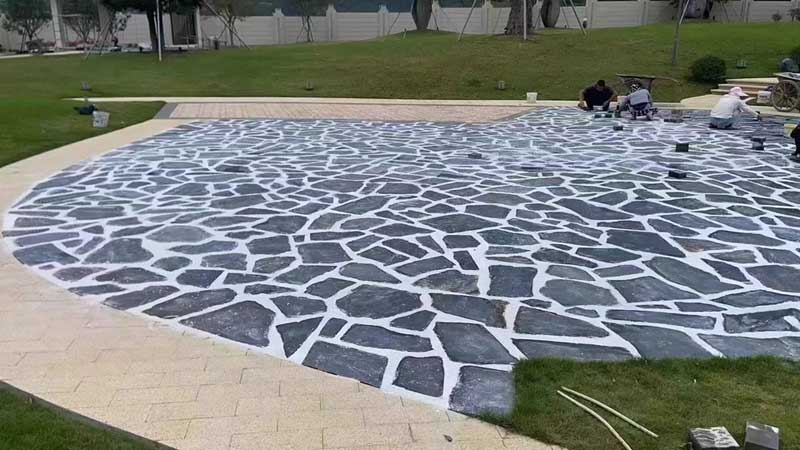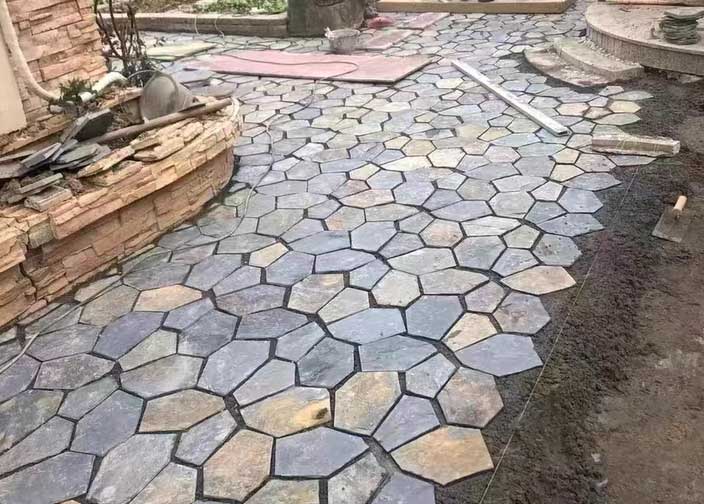¿Dividido entre el encanto rústico de la piedra suelta y las líneas limpias de los adoquines? No estás solo. Innumerables propietarios de viviendas luchan con la selección de materiales al crear espacios al aire libre que se sienten cohesivos y cautivadores. El enfoque típico de un material a menudo deja paisajes que se sienten planos, predecibles y carentes de personalidad.
Los paisajes de materiales mixtos ofrecen la solución perfecta al combinar elementos naturales con los fabricados. Combinando estratégicamente piedra suelta Con adoquines, ladrillos y elementos de madera, puede crear espacios al aire libre con profundidad, textura e interés visual que sea imposible de lograr con diseños de un solo material. Estas combinaciones dinámicas no solo mejoran el atractivo estético, sino que también le permiten adaptar diferentes áreas de su patio a funciones específicas mientras mantiene un lenguaje de diseño unificado. Desde la creación Drop Dead Gorgeous caminos que guían a los visitantes a través de su jardín para construir transiciones entre las habitaciones al aire libre, las posibilidades son prácticamente ilimitadas.
El arte y la ciencia de los paisajes de materiales mixtos
Hay algo casi mágico en un paisaje que combina perfectamente diferentes materiales. Un camino que pasa de adoquines lisos a madera rústica, bordes donde la piedra se encuentra con el ladrillo o las áreas donde la grava suelta fluye junto a elementos estructurados. Esta armonía de texturas no es solo visualmente impresionante, es la esencia de un paisaje material mixto que crea profundidad, interés y funcionalidad en los espacios al aire libre.
Los paisajes de materiales mixtos combinan elementos como piedra, adoquines, ladrillos y madera para crear espacios al aire libre visualmente dinámicos que ofrecen beneficios prácticos y atractivo estético.
Definición de paisajes de materiales mixtos: una introducción
Un material mixto El paisaje combina intencionalmente múltiples elementos: piedra viva, pavers, bricks, and wood—to create a cohesive outdoor environment that’s greater than the sum of its parts. Rather than limiting your design to a single material, this approach celebrates the unique characteristics each element brings to the table.
When executed thoughtfully, a mixed material landscape creates visual rhythm and flow. The contrast between rough and smooth, geometric and organic, or dark and light materials guides the eye through the space while creating “eye candy” moments that surprise and delight visitors as they move through your garden or yard.
Why Choose Mixed Materials? Aesthetics, Functionality, and Sustainability
Beyond their visual appeal, mixed material landscapes offer practical advantages. Different materials perform differently under various conditions—wood provides warmth and natural appeal, stone delivers durability and timelessness, while pavers offer precision and structure. By combining these elements strategically, you can address specific needs throughout your landscape.
Mixed material landscape design allows for better water management, with permeable sections to absorb rainfall alongside solid surfaces that direct water flow. This thoughtful approach creates microclimates that support diverse plant life while reducing runoff and erosion—a win for both aesthetics and environmental responsibility.
Additionally, using mixed materials often proves more economical, as you can allocate higher-end materials to focal points while using more budget-friendly options in less prominent areas.
Performance Comparison of Materials in Mixed Landscapes
| Material Property | Piedra suelta | Adoquines de hormigón | Piedra natural | Clay Brick | Treated Wood |
|---|---|---|---|---|---|
| Costo inicial ($/sq.ft) | 1-5 | 2-8 | 15-30 | 6-12 | 7-15 |
| Vida útil (años) | 10-15 | 25-50 | 50+ | 20-30 | 7-15 |
| Nivel de mantenimiento | Moderado | Bajo | Bajo | Bajo | Alto |
| Retención de calor | Bajo | Alto | Medio | Alto | Bajo |
| Permeabilidad al agua | Alto | Low/Medium | Bajo | Bajo | Medio |
| Slip Resistance | Medio | Medium/High | Variable | Medio | Low when wet |
Design Principles: Harmony, Contrast, and Balance
Creating a successful mixed material landscape relies on three core principles: harmony, contrast, and balance. Harmony comes from repeating elements—perhaps using the same loose stone in multiple areas to create a cohesive thread. Contrast emerges from juxtaposing different textures and colors, like pairing smooth pavers with rough-hewn wood. Balance ensures no single material dominates unless intentionally designed to do so.
The growing trend in both residential and commercial projects shows landscape designers increasingly embracing mixed materials to create distinctive outdoor spaces. High-quality materials from reputable suppliers like Top Source Slate ensure these designs maintain their integrity over time, with piedra natural products forming the backbone of many mixed material designs.
Incorporating water features alongside mixed materials enhances the sensory experience, creating a seamless blend of nature and design. The sound of water flowing over stone, reflecting wooden elements, or framed by brick borders adds another dimension to your landscape, engaging multiple senses and deepening the connection between people and their outdoor environment.
Practical Guide to Combining Loose Stone with Pavers, Bricks, and Wood
Imagine walking through a garden where smooth pavers transition into a rustic pebble path, bordered by warm wooden accents and framed with natural stone. This isn’t just a garden—it’s a tactile adventure that invites exploration and discovery. Creating these mixed material landscapes might seem like an art reserved for professional designers, but with the right approach, anyone can craft these dynamic outdoor spaces.
Combining loose stone with pavers, bricks, and wood creates visually striking landscapes that balance natural beauty with practical functionality, allowing homeowners to craft unique outdoor spaces that reflect their personal style.
Creating Dynamic Pathways: Step-by-Step Guide
The secret to a successful mixed media garden path lies in thoughtful transitions. Start by mapping your path’s journey—where does it begin and end? Which areas receive heavy foot traffic and which are purely decorative? Use this information to determine where each material makes the most sense.
For high-traffic areas, consider using solid pavers or bricks as your foundation. As the path curves into more decorative sections, begin introducing loose stone. The transition point is where magic happens—try creating a “fade out” effect by gradually increasing the spacing between pavers and filling with matching gravel or pebbles.
When selecting materials, consider how they relate to each other. Slate pavers paired with dark river rock create a smooth visual flow, while terracotta bricks with light pebbles offer dramatic contrast. Remember to install proper edging—whether metal, plastic, or natural stone—to prevent loose materials from migrating where they shouldn’t.
Integrating Natural Wood Elements: Decks, Edging, and Decorative Accents
Wood brings warmth and organic texture to stone and wood landscaping projects. Consider raised wooden boardwalks over sections of loose stone for a striking visual effect, or use timber sleepers as steps through a sloped gravel area. Even simple wooden edging can frame loose stone beautifully, creating definition and preventing scatter.
For a more subtle approach, incorporate wooden elements as accents—think cedar stepping discs partially submerged in pebbles or reclaimed wood benches positioned strategically along your paver pathway. These elements can serve as focal points and rest areas while enhancing the natural feel of your landscape.
Material Performance Comparison for Mixed Landscape Applications
| Tipo de material | Costo inicial ($/sq.ft) | Complejidad de instalación | Durability (years) | Maintenance Requirements | Best Application Areas |
|---|---|---|---|---|---|
| Loose Slate Chips | 3-6 | Bajo | 10-15 | Moderate (Annual refreshing) | Decorative areas, drainage zones |
| Piedra natural Adoquines | 15-25 | Alto | 50+ | Low (Occasional cleaning) | Main pathways, focal points |
| Clay Brick | 7-12 | Medio | 30-40 | Medium (Weed control) | Traditional garden paths, borders |
| Cedar Lumber | 8-14 | Medio | 7-10 | High (Annual sealing) | Edging, raised elements |
| Cubierta compuesta | 15-30 | Medio | 20-30 | Very Low (Occasional washing) | Transition areas, boardwalks |
| Adoquines de hormigón | 5-10 | Medio | 25+ | Low (Occasional sealing) | High-traffic pathways, patios |
Drainage Solutions: Ensuring Longevity and Material Stability
The success of a mixed material landscape often depends on what’s happening beneath the surface. Create a solid foundation with proper drainage layers—typically starting with larger crushed stone, followed by finer gravel, and finally a layer of sand for pavers or bricks. For areas with loose stone, ensure a slight gradient (about 1-2%) away from structures to prevent water pooling.
Incorporate permeable sections within your design to allow water to percolate naturally into the soil. This strategic approach not only prevents runoff but also reduces the risk of material displacement during heavy rain. Consider installing hidden French drains beneath particularly vulnerable sections of your mixed media paths to channel water away effectively.
For projects using Top Source Slate products, their precisely cut stone panels can be installed with minimal spacing to create effective drainage channels while maintaining a clean, professional appearance. Ready-to-ship options from their catalog offer cost-effective solutions for standard applications, while custom orders allow for specific dimensions tailored to unique drainage requirements.
Incorporating small water features alongside your stone and wood elements can transform necessary drainage solutions into design highlights. A simple stone-lined dry creek bed that comes alive during rainfall adds dynamic interest while serving a practical purpose in your landscape design.
Conclusión
Mixing materials in your landscape isn’t just about aesthetics; it’s about crafting an experience. As someone who’s spent years in the stone industry, I’ve seen firsthand how the right combination of textures and materials can transform an ordinary outdoor space into something truly special.
My experience at Top Source Slate has shown me the importance of quality materials. Combining our piedra natural with wood, pavers, or brick allows you to create stunning, durable landscapes that stand the test of time. It’s about finding that sweet spot where functionality meets beauty.
Ultimately, designing a mixed material landscape is a piece of cake when you focus on creating harmony and balance. So, go ahead, experiment with different textures and let your personal style shine through. The possibilities are endless!


